Sports are not often the first thing to come to mind when looking to address trauma. At Up2Us Sports, we're working to change that. When implemented by a trained coach who can create a safe space for youth, sports can be a positive experience for youth with a past of adverse childhood experiences. Below is an example of the structure of a trauma-sensitive sports practice.
TRANSITION
A good transition starts at least 30 minutes before practice is going to start. Players are given time and space to adjust to their new context. A transition lays the groundwork for safety because it is consistent and youth-directed. Transitions help start players down the pathway to being present.
Space: Coaches set the space up in a consistent way so players know what to expect and gives them options to choose from to help facilitate their transition.
Interactions: Coaches create opportunities for informal connection by setting up optional collaborative activities and offering high-fives, handshakes, light inquiries, and check-ins.
Rituals: Kids are in charge of how they use their time, but coaches offer consistent markers or countdowns to help kids stay oriented towards what’s ahead.
WARM-UP
A trauma-sensitive warm-up routine helps the team and each individual player get ready by engaging in consistent activities that include choice elements. It’s a time for players to get oriented towards their bodies and the good and bad stress of the day.
Check in: Coaches facilitate reflection for players about how they are feeling, what’s happening in their bodies and what to expect for the day.
Warm-Up Activities: Coaches design an active team routine in which the experience becomes centered around the body and help players identify the things they need to do as individuals to get themselves ready.
Huddle Up: Coaches share the expectations of the day and work with players to identify and prepare for potential moments of bad stress.
PLAY
During the “play” phase, coaches help players gain and maintain competence, control, and positive connections. They manipulate activities and the environment to help every kid “get a win” and try and string those wins together so that they get on a “hot streak.”
Bridge: Coaches build competence by recognizing small accomplishments and using the momentum to engage in the next activity
Boost: Anticipating when a player might get off track, coaches offer an opportunity for players to reset and get another win.
Break: Coaches offer the chance for players to opt out of bad stress (wherever that may be) by calling their own time out, adopting a mistake ritual, or going to the “reset” zone where a player can work on fundamentals until they get back to good stress.
COOL DOWN
The cool down phase acknowledges that it takes a while to reset the body after being active. It gives ownership of this resetting process to the players and helps them prepare for the upcoming transition (which may be to a less safe space).
Ending Tradition: Coaches offer a game or scrimmage that is always a marker for practice approaching its close and helps kids leave on a high note.
Cool down: Coaches design an active team routine in which the experience becomes centered around the body (how to take ownership over decreasing the heart rate) and help players identify the things they need to do as individuals to get themselves ready to transition.
Team Time: Coaches facilitate a consistent conversation where players get to connect with each other and talk about whatever they want to share.
TRANSITION
A good transition lasts for at least 30 minutes. It reinforces the safety of the space by allowing players enough time to manage the close of practice and prepare for what comes next.
Space: Coaches stay in the room and leave equipment out for any player who wants to “play out” some lingering part of the game.
Interactions: Coaches remain available for informal interactions or intentional interventions with players who might benefit from more help moving on to the next thing.
Rituals: Kids are in charge of how they use their time, but coaches offer consistent markers or countdowns to help kids stay oriented towards what’s ahead.
Content developed in partnership with Edgework Consulting.






